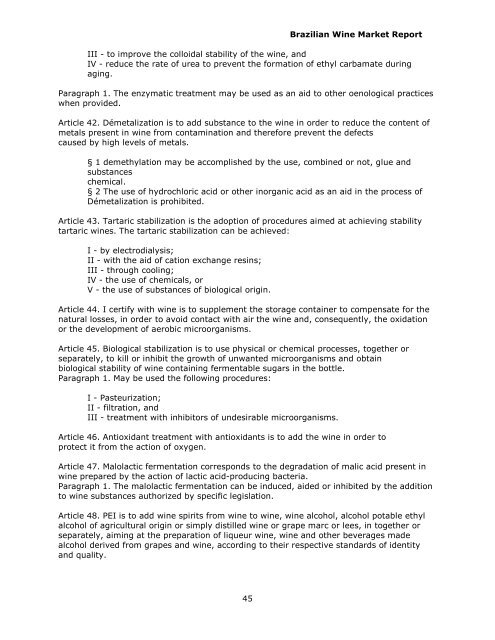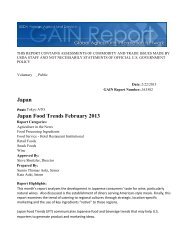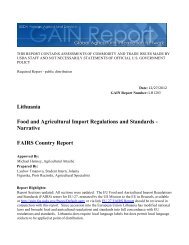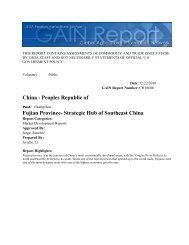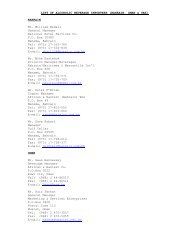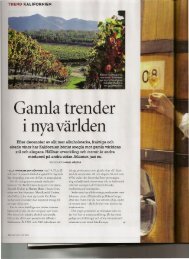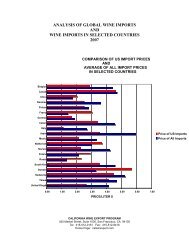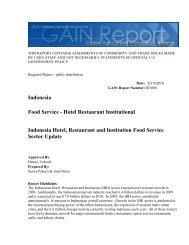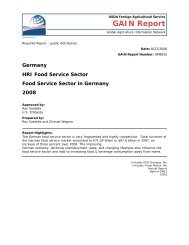Brazil Wine Market Report JBC EMP July 2011 - California Wine ...
Brazil Wine Market Report JBC EMP July 2011 - California Wine ...
Brazil Wine Market Report JBC EMP July 2011 - California Wine ...
Create successful ePaper yourself
Turn your PDF publications into a flip-book with our unique Google optimized e-Paper software.
45<br />
<strong>Brazil</strong>ian <strong>Wine</strong> <strong>Market</strong> <strong>Report</strong><br />
III - to improve the colloidal stability of the wine, and<br />
IV - reduce the rate of urea to prevent the formation of ethyl carbamate during<br />
aging.<br />
Paragraph 1. The enzymatic treatment may be used as an aid to other oenological practices<br />
when provided.<br />
Article 42. Démetalization is to add substance to the wine in order to reduce the content of<br />
metals present in wine from contamination and therefore prevent the defects<br />
caused by high levels of metals.<br />
§ 1 demethylation may be accomplished by the use, combined or not, glue and<br />
substances<br />
chemical.<br />
§ 2 The use of hydrochloric acid or other inorganic acid as an aid in the process of<br />
Démetalization is prohibited.<br />
Article 43. Tartaric stabilization is the adoption of procedures aimed at achieving stability<br />
tartaric wines. The tartaric stabilization can be achieved:<br />
I - by electrodialysis;<br />
II - with the aid of cation exchange resins;<br />
III - through cooling;<br />
IV - the use of chemicals, or<br />
V - the use of substances of biological origin.<br />
Article 44. I certify with wine is to supplement the storage container to compensate for the<br />
natural losses, in order to avoid contact with air the wine and, consequently, the oxidation<br />
or the development of aerobic microorganisms.<br />
Article 45. Biological stabilization is to use physical or chemical processes, together or<br />
separately, to kill or inhibit the growth of unwanted microorganisms and obtain<br />
biological stability of wine containing fermentable sugars in the bottle.<br />
Paragraph 1. May be used the following procedures:<br />
I - Pasteurization;<br />
II - filtration, and<br />
III - treatment with inhibitors of undesirable microorganisms.<br />
Article 46. Antioxidant treatment with antioxidants is to add the wine in order to<br />
protect it from the action of oxygen.<br />
Article 47. Malolactic fermentation corresponds to the degradation of malic acid present in<br />
wine prepared by the action of lactic acid-producing bacteria.<br />
Paragraph 1. The malolactic fermentation can be induced, aided or inhibited by the addition<br />
to wine substances authorized by specific legislation.<br />
Article 48. PEI is to add wine spirits from wine to wine, wine alcohol, alcohol potable ethyl<br />
alcohol of agricultural origin or simply distilled wine or grape marc or lees, in together or<br />
separately, aiming at the preparation of liqueur wine, wine and other beverages made<br />
alcohol derived from grapes and wine, according to their respective standards of identity<br />
and quality.


